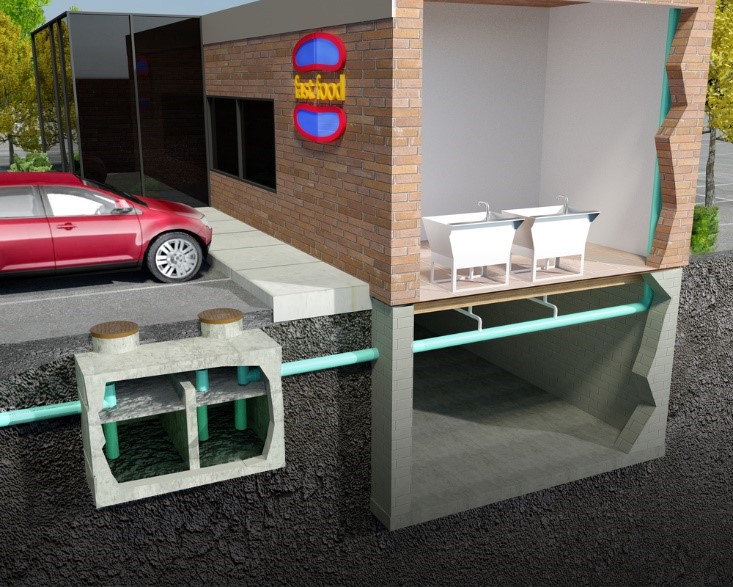Commercial kitchen owners and managers understand that keeping the restaurant grease trap in their establishment’s sewage disposal system functioning correctly is critical. However, we all get overwhelmed with business matters and sometimes forget to schedule key maintenance tasks.
But what can happen if your restaurant’s grease trap goes unpumped for too long? In addition to falling out of compliance with local regulations, which could result in fines for your business, ignoring your grease traps can lead to big messes that are costly to clean up.
Today’s blog post lays out some of the biggest reasons to have your commercial grease traps professionally cleaned and serviced regularly. Plus, if you need help remembering to get your grease traps maintained, we can set up a preventative maintenance plan to get your business into a routine you can nearly “set and forget.” (Just contact us at Biros to learn more.)
Quick Review: How Does a Restaurant Grease Trap Operate?
Whether you call them grease interceptors, grease traps, or even “the grease pit,” one thing is sure. These devices are essential to separating fats, oil, and grease (FOG) from your restaurant’s wastewater as it moves from your washing equipment and sinks through your drain lines and into sewer lines or septic tanks.
Most grease traps’ operation is passive—much like how a septic tank operates in residential or commercial establishments that do not have municipal sewer service. And, in fact, your restaurant may have both a grease trap and a septic tank.
The working principle of a grease trap is essentially this:
- When the outflow from the kitchen sink or dishwashing equipment enters the grease trap, solid food particles will sink to the bottom, while lighter grease and oil floats to the top.
- Baffles are typically part of the system and help retain grease toward the grease trap’s upstream end since grease floats and will generally not go under the baffles. This helps prevent grease from leaving the grease trap and moving further downstream, where it can cause blockage problems.
- An air intake valve allows air into the open space inside the grease trap to prevent back-pressure.
- The mostly grease-free water can then flow freely into the regular septic system or sewer lines.
- The food solids at the bottom and floating oil and grease must be periodically removed in a manner similar to septic tank pumping.
Restaurant employees need to understand that a standard grease trap is not a food disposal unit. Unfinished food should be scraped into the garbage or food recycling bin instead of washed down a sink or drain. Liquefied food substances like milkshakes, gravy, and sauces must also be scraped off dishes before being washed in the sink or dishwasher.
Why Keep Your Restaurant Grease Trap Maintained?
In short, keeping your grease trap maintained may be required by your local sewer authority and other governmental bodies. But you also risk creating big problems within your business if you ignore your grease traps. Plumbing issues are pretty much guaranteed if you don’t have your grease traps professionally serviced on a regular basis, and you could be setting yourself up for much more damaging situations—including kitchen fires.
Prevent Grease Trap Clogs
FOG substances are extremely good at creating clogs because they harden and become quite sticky over time. Preventing clogs means removing these substances from the grease trap before they build up to dangerous levels that no longer allow water to pass through.
What happens if you allow FOG to accumulate for long periods? You can easily wind up with a difficult to clean—perhaps even toxic—sludge that may back up into your commercial kitchen, forcing costly downtime for cleanup.
Keep Unappetizing Smells Away
Even if you have never taken a look inside your grease trap and experienced the accompanying “aroma,” you’re probably not surprised to learn that built-up FOG substances smell pretty terrible. If you fail to keep your restaurant’s grease traps maintained, those smells will force their way back inside and certainly turn diners away. Don’t risk the negative reviews that come with unappealing odors in your foodservice business.
Avoid Creating Health Hazards
One reason local authorities and government bodies establish rules about wastewater disposal is the risk to human health that clogged, dirty, or malfunctioning equipment poses. When grease traps in your commercial kitchen back up, your water source can be contaminated, which could make it so your business can’t safely operate.
Prevent Kitchen Fires
Did you know that a grease trap clog makes it that much more likely that a kitchen fire will occur? Fats, oils, and grease are highly flammable, and not practicing good grease trap maintenance means you have more of these substances hanging around than is advisable. If a small kitchen fire starts, your clogged grease trap could make it that much more challenging to get under control, which is bad news for your business.
Save Money
There are lots of ways that poor grease trap cleaning habits cost your restaurant extra. Clogs can equal costly plumbing damage and even fines for creating health hazards, as we mentioned above. Can your restaurant afford these types of unanticipated costs?
Instead of taking a gamble with grease trap clogs, why not get a regular grease trap service routine in place with a professional provider who cares about your business’s success?
Need to Schedule Grease Trap Service in the Scranton, PA Area?
Here at Biros Septic & Drain Cleaning, we specialize in the removal and proper disposal of kitchen grease waste. We provide full documentation back to you to prove compliance with any regulations, too.
When you need help managing FOG substances, grease trap cleaning, or you’re building out a new restaurant location and need new grease trap equipment installed, get in touch with Biros for fast and friendly service!

